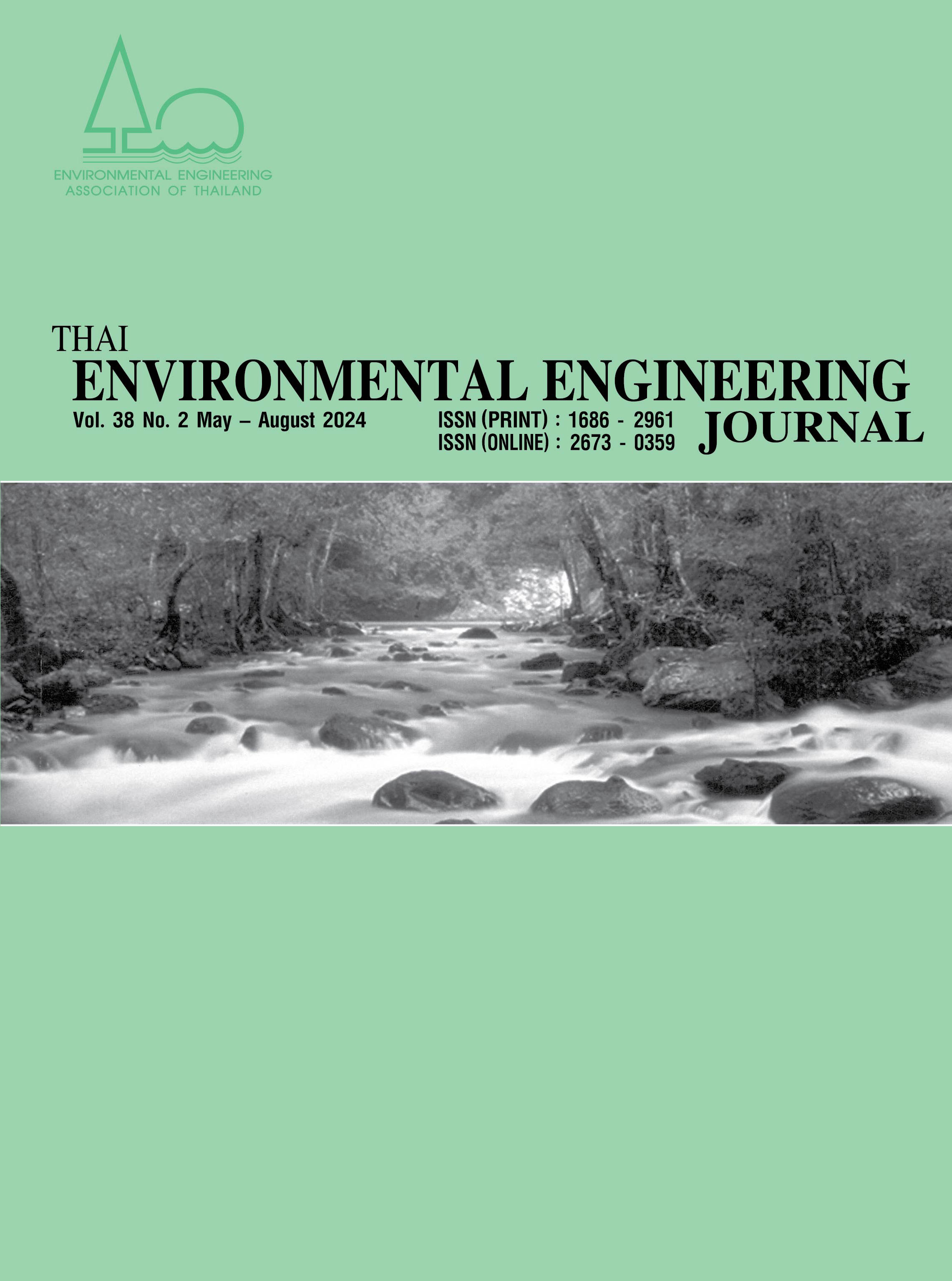The Effect of Bromide Ions on the Formation of Brominated Haloacetic Acids (Br-HAAs) in Tropical Rivers, Thailand
Main Article Content
Abstract
With the presence of bromide ions in chlorination during water purification, hypobromous acid (HOBr) is formed, leading to the formation and distribution of brominated disinfection by-products (Br-DBPs) in tap water. Brominated haloacetic acids (HAAs) in tap water are known to be significantly harmful and toxic to human health. Bromide ions are naturally present in groundwater and surface water, primarily as affected by seawater intrusion. Conventional treatment methods face difficulty in completely eliminating bromide ions. This study investigated the concentration of bromide ions and the haloacetic acid formation potentials (HAAFPs) in three tropical river sources in Thailand: the Tha-Chin River, the Chao Phraya River, and the Mae Klong River. The bromide ion concentrations were 44.79, 41.34, and 18.22 µg/L, respectively. In these three rivers, chlorinated and brominated HAAs (trichloroacetic acid (TCAA), dichloroacetic acid (DCAA), bromodichloroacetic acid, and bromochloroacetic acid) were detected after chlorination. The sum of only DCAAFPs and TCAAFPs were significantly higher than the US EPA regulations of 60 µg/L for total HAA5 (the sum of monochloroacetic acid, monobromoacetic acid, DCAA, dibromoacetic acid, and TCAA). The DCAAFPs in the Chao Phraya River were relatively high, surpassing the WHO guidelines of 50 µg/L. This study also found that the Tha-Chin River had high levels of bromide ions and brominated HAAFPs, resulting from seawater intrusion from the estuary Gulf. These findings highlighted the formation of brominated HAAFPs, which were particularly significant in water sources with higher levels of bromide ions in the water.
Article Details
References
Krasner, S.W., Westerhoff, P., Chen, Z., Amy, G., and Croué, J.P. 2006. Occurrence of a new generation of disinfection byproducts. Environmental Science & Technology, 40(23): 7175-7185.
Richardson, S.D., Plewa, M.J., Wagner, E.D., Schoeny, R., and DeMarini, D.M. 2007. Occurrence, genotoxicity, and carcinogenicity of regulated and emerging disinfection by-products in drinking water: A review and roadmap for research. Mutation Research, 636(1-2): 178-242.
Park, K.-Y., Kim, J., Lee, Y., and Shin, H. 2019. Natural organic matter removal from algal-rich water and disinfection by-products formation potential reduction by powdered activated carbon adsorption. Journal of Environmental Management, 235: 310-318.
Liang, L. and Singer, P.C. 2003. Factors influencing the formation and relative distribution of haloacetic acids and trihalomethanes in drinking water. Environmental Science & Technology, 37(13): 2920-2928.
Ersan, M.S., Wols, B., Harmsen, D., and Medema, G. 2019. The interplay between natural organic matter and bromide on bromine substitution. Science of the Total Environment, 646: 1172-1181.
Kumar, K. and Margerum, D.W. 1987. Kinetics and mechanism of general-acid-assisted oxidation of bromide by hypochlorite and hypochlorous acid. Inorganic Chemistry, 26(16): 2706-2711.
Liu, Y., Yu, L., Huang, J., and Wang, Y. 2022. Formation of regulated and unregulated disinfection byproducts during chlorination and chloramination: Roles of dissolved organic matter type, bromide, and iodide. Journal of Environmental Sciences, 117: 151-160.
Cowman, G.A. and Singer, P.C. 1995. Effect of bromide ion on haloacetic acid speciation resulting from chlorination and chloramination of aquatic humic substances. Environmental Science & Technology, 30(1): 16-24.
Alsulaili, A.D. 2009. Impact of bromide, NOM, and pre-chlorination on haloamine formation, speciation, and decay during chloramination. Water Research, 43(5): 1432-1440.
Heller-Grossman, L., Heller, M., and D. S. M. Barak. 1993. Formation and distribution of haloacetic acids, THM, and TOX in chlorination of bromide-rich lake water. Water Research, 27(8): 1323-1331.
Westerhoff, P., Chao, P., and Mash, H. 2004. Reactivity of natural organic matter with aqueous chlorine and bromine. Water Research, 38(6): 1502-1513.
Siddiqui, M.S., Amy, G.L., and Rice, R.G. 1995. Bromate ion formation: a critical review. Journal‐American Water Works Association, 87(10): 58-70.
Sohn, J., Amy, G., and Yoon, Y. 2006. Bromide ion incorporation into brominated disinfection by-products. Water, Air, and Soil Pollution, 174(1-4): 265-277.
Liu, S., Zhang, Y., Wang, Y., and Chen, Y. 2011. Seasonal variation effects on the formation of trihalomethane during chlorination of water from Yangtze River and associated cancer risk assessment. Journal of Environmental Sciences (China), 23(9): 1503-1511.
Kampioti, A.A. and Stephanou, E.G. 2002. The impact of bromide on the formation of neutral and acidic disinfection by-products (DBPs) in Mediterranean chlorinated drinking water. Water Research, 36(10): 2596-2606.
Tada, Y., Nakagawa, T., Matsumoto, S., and Sakurai, K. 2023. High formation of trichloroacetic acid from high molecular weight and ultra-hydrophilic components in freshwater raphidophytes upon chlorination. Science of the Total Environment, 879: 163000.
Cowman, G.A. and Singer, P.C. 1995. Effect of bromide ion on haloacetic acid speciation resulting from chlorination and chloramination of aquatic humic substances. Environmental Science & Technology, 30(1): 16-24.
Kharkar, D., Turekian, K.K., and Bertine, K.J. 1968. Stream supply of dissolved silver, molybdenum, antimony, selenium, chromium, cobalt, rubidium, and cesium to the oceans. Geochimica et Cosmochimica Acta, 32(3): 285-298.
Marhaba, T.F., Murthy, S.K., and Parulekar, S.J. 2006. Trihalomethanes formation potential of shrimp farm effluents. Journal of Hazardous Materials, 136(2): 151-163.
Zheng, L., Xu, Z., Huang, Y., and Zhang, H. 2020. Precursors for brominated haloacetic acids during chlorination and a new useful indicator for bromine substitution factor. Science of the Total Environment, 698: 134250.
Volk, C., Hübner, U., and Koch, C. 2002. Monitoring dissolved organic carbon in surface and drinking waters. Journal of Environmental Monitoring, 4(1): 43-47.
Wang, Y., Small, M.J., and VanBriesen, J.M. 2017. Assessing the risk associated with increasing bromide in drinking water sources in the Monongahela River, Pennsylvania. Journal of Environmental Engineering, 143(3): 04016089.
World Health Organization. 2011. WHO Guidelines for Drinking-Water Quality, 4th edition. Geneva: World Health Organization.
U.S. Environmental Protection Agency. 2010. Stage 2 Disinfectants and Disinfection By-Products Rule: A Quick Reference Guide for Schedule 1 Systems. EPA 815-K-09-003.
Uyak, V. and Toroz, I. 2007. Investigation of bromide ion effects on disinfection by-products formation and speciation in an Istanbul water supply. Journal of Hazardous Materials, 149(2): 445-451.


